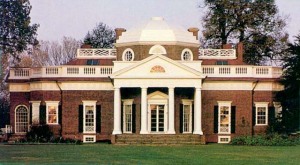Thomas Jefferson was an italophile. What an honor for Italian culture that a man of his brilliance and esteem would find value in it. (link to In Love with Italy website.)

"...Jefferson's first serious study of the Italian language probably began in 1764, when he purchased an Italian-English dictionary and three historical works in Italian. If by 1767 he saw a copy of Andrea Palladio's Four Books of Architecture in the original Italian, he may have been struck by Palladio's account of his most famous structure, the Villa Rotunda near Vicenza. The architect who most influenced the design of the first Monticello house described the Villa's particularly delightful situation on the top of "monticello," on one side washed at its base by a navigable river and on the other surrounded by cultivated hills abounding in fruits and forming a "gran Teatro."
"Whatever the direct inspiration, the indirect source of the name Monticello was undoubtedly Jefferson's early and intense study of the classical world and his deep identification with Roman culture. He filled pages of his Commonplace Book with extracts from well loved poems of Augustan Rome. He derived continuous architectural inspiration from Roman villas and their sixteenth-century Palladian descendants, and he considered the agriculture of the time of Cato and Varro as the origin of and model from modern husbandry. It is apparent that he regarded modern Italians as the heirs of the classical tradition. He believed that correct pronunciation of the Latin language could be learned in Italy and perhaps he felt that traces of the idealized rural life so vividly portrayed in the poetry of Horace and Virgil might yet survive on Italian soil."
"And so, when a boatload of Tuscan farmers, animals and plants arrived in Virginia in 1773, Jefferson may have viewed it as a delegation from an ancient world. The conductor of this small band of colonizers was Filippo Mazzei, who in his forty-three years had been an itinerant surgeon, a teacher of Italian, and a wine merchant, and was now intent on initiating trade between Virginia and Italy and establishing the culture of some of the agricultural productions of the Mediterranean. Mazzei, on his way to the Shenandoah Valley to settle, was intercepted in his passage by his host at Monticello, where he had stopped for an introductory visit. Jefferson gave him a small parcel of land on the fringes of his own property, Mazzei purchased additional acreage, and a third Italian hill, Colle, joined Monticello and Montalto in a neighborhood of farms and names like Clover Fields, Edgehill, and Buck Island"
"...It was in 1778, when Jefferson enlarged his orchard and made a detailed plan of its contents, that he could not remain satisfied with only Italian plants and farmers, but sought to introduce Italian fine arts, especially music, which he said was in Virginia in a state of "deplorable barbarism."
It's an interesting read.


This is fascinating. I knew some – but not the degree in which Jefferson embraced Italian culture. Must investigate more.
ReplyDeleteLooks somewhat like the white house!
ReplyDeleteVery Nice
I lived very near Jefferson's home and visited quite often. Palladio's influence in American architecture is considerable, sometimes via Jefferson as is often the case in homes, and other buildings around Virginia.
ReplyDelete